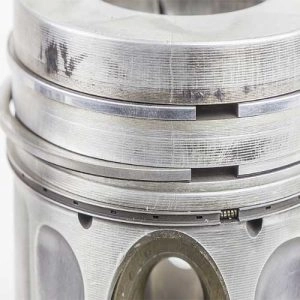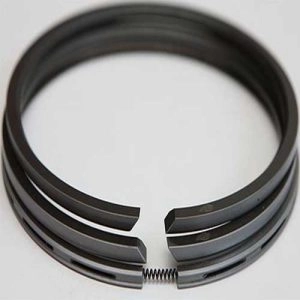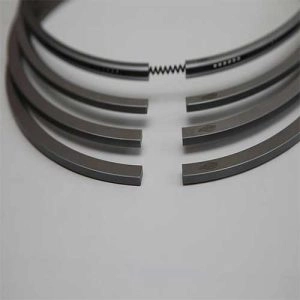Engine oil is one of the most important fluids in a car, as it is essential for maintaining the operation of the most important and sensitive parts of the car, especially the engine. Of course, its operation and regulation will not be arbitrary, but its consumption must be adjusted, and the appropriate conditions for its operation must be maintained. From this standpoint, there was a need to provide parts that perform these regulatory tasks that the engine oil constantly needs, which will be the focus of our discussion in this article. These parts are the bearings, and we will explain their importance and highlight the top 5 signs indicating their damage.
What are the spark plugs?

They are a set of rings that surround the pistons, playing a vital role by regulating the pressure of the engine oil, in addition to their importance in regulating the amount of engine oil consumed. Despite their small size, their role is significant and important. They are necessary for the engine to function, and without them, the car's engine would suffer from wear and tear.
In general, most internal combustion engines have pistons that work in cooperation with air and fire valves to close the combustion chamber when the fuel mixture ignites. This ignition propels the pistons down the cylinder, producing force that drives the car. Therefore, it is necessary to ensure that the pistons seal the cylinder walls tightly, preventing any leakage, ensuring complete ignition of the mixture. This is done with the help of piston rings.
What are the functions of the spark plugs?

The 4 main important functions of the brake calipers, which we will clarify for you in this paragraph, are:
Support the Pistons
The presence of piston rings provides a cushioned support for pistons, preventing them from colliding with the cylinder wall. The pistons operate by rotating the crankshaft, and without the rings, the pistons would easily collide with the cylinder wall.
Maintaining the pressure
Valves help to keep the combustion chamber tightly closed to prevent any leakage of gases outside the chamber, which significantly increases the engine's efficiency and performance.
Heat Dissipation
A significant rise in temperature within the combustion chamber can cause severe damage. Since the temperature increases each time combustion occurs, it is necessary to secure a tool that constantly helps to dissipate the excess heat. The best tool for this purpose is the fins. The fins assist in transferring the excess heat from the piston head and discharging it to the cylinder, thus ensuring protection from damages caused by rising temperatures.
Controlling the Lubrication
This job is one of the most important tasks of the lobes, as they help regulate the amount of oil reaching the pistons, ensuring they function properly.
Also read:4 Signs Indicating Damage to the Valve Cover
Signs of Damaged Springs

Many online searches ask "How do you know if the clutch is broken?" and "When should the clutch kit be changed?" among other questions. Now is the time to answer these inquiries. In this section, we will illustrate the top 5 signs that warn of a malfunction in the clutch. These signs are:
The engine oil is rapidly depleting.
A decrease in the amount of engine oil could be a clear indicator of a problem with the rod bearings, as damage to these bearings can cause the oil to leak into the combustion chamber, reducing its quantity rapidly. Consequently, the driver would need to add specified amounts of oil from time to time, whereas under normal circumstances, they wouldn't need to add engine oil to the car until after traveling a distance ranging between 5000-7500 km.
Engine pressure drop
A decrease in engine pressure is one of the most prominent signs indicating some damage to the pistons. It is also the definitive evidence to determine whether the pistons are damaged or if it's the engine valves, especially since many people may confuse the two due to the similar symptoms of their damage. The pressure of each cylinder is measured, and if the pressures are relatively equal and match what is specified in the car's maintenance manual, this signifies that the vehicle's pistons are in good condition. On the other hand, a decrease in pressure value indicates damage to the pistons. This shortage in pressure will result in reducing the power resulting from fuel combustion, and the engine will not operate correctly under this condition.
In addition to the above, the pressure value in the healthy engine should exceed 115PSI, provided that there is no difference exceeding 10% between the highest and the lowest reading.
Loss of Torque
As we mentioned above, damage to the valves will affect the pressure value inside the combustion chambers, which in turn leads to reduced productivity and efficiency of the engine. The driver will notice a decrease in its performance and a significant drop in acceleration.
Increased exhaust smoke
If you are looking for a clear sign of car hub damage, increased exhaust smoke is the most prominent and obvious indicator of damage. This is because hub malfunction can lead to engine oil leaking into the combustion chamber, resulting in a different combustion than normal in terms of smoke density, color, and smell. It produces dense smoke with a gray, blue color accompanied by the smell of burnt oil.
There is oil on the air filter.
If you find drops of engine oil on the hose leading to the air filter, or on the air filter itself, this may be a clear sign of damage.Spark PlugsIn the car.

Comments